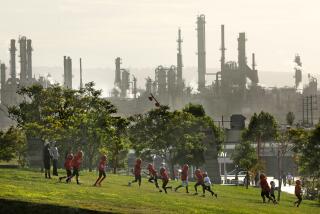Exxon Drops Plan to Run Tankers in Channel : Business: Company will ship crude from offshore fields through pipeline. Environmentalists hail the decision.
- Share via
Exxon Corp. has withdrawn its application to run oil tankers through the Santa Barbara Channel and instead plans to use an existing overland pipeline to ship crude from its oil fields off the shore of Santa Barbara to refineries in Los Angeles.
The oil company’s announcement was applauded immediately by environmentalists as a victory for the ecologically fragile coastline and Channel Islands.
“This decision will secure long-term protection for the California coast,” said Linda Krop, an attorney with the Environmental Defense Center in Santa Barbara.
Last year, Exxon sought permission to ship as much as 50,000 barrels a day of crude down the coast in single-hulled tankers. Santa Barbara County officials were drafting an environmental impact report on the request when Exxon decided last Wednesday to withdraw its controversial proposal.
Exxon spokesman Les Rogers said the company determined that using the overland All American Pipeline would be more economical.
He said the company’s new strategy gives it a long-term means of transporting oil pumped from its offshore platforms near a marine tanker terminal at Gaviota in northern Santa Barbara County.
Exxon’s decision to abandon tankers comes a few months after Chevron Corp. won permission to use tankers to move crude from the massive Point Arguello offshore oil fields to refineries near Wilmington.
After Chevron had spent a decade of regulatory and environmental struggles to secure a shipping permit, the California Coastal Commission ruled earlier this year that the company could ship oil--about one tanker trip a week--until 1996. At that time, ocean shipping must cease, and crude oil from the area must be moved by pipeline over land.
Chevron and other oil companies that own the Point Arguello fields also signed contracts to send the crude through the All American Pipeline to refineries after the shipping permit expires. That contract ended a competition between pipeline companies to build a 171-mile pipe from Santa Barbara to Los Angeles.
By using the existing All American Pipeline, Exxon’s oil from its Santa Ynez Unit field will travel north to near Santa Maria and east to Kern County and San Bernardino counties before jogging south to Los Angeles-area refineries.
In its application for tankers, Exxon proposed to use only single-hulled vessels to ferry oil down the coast--a prospect that frightened environmentalists in Ventura and Santa Barbara counties because of the risk of oil spills in the Santa Barbara Channel.
“After the (1989) Exxon Valdez accident, it was alarming to think the company would think to use single-hulled tankers,” said Krop of the Environmental Defense Center, a law firm representing a coalition of environmental organizations.
“Exxon’s decision to use onshore pipelines instead of oil tankers will hopefully set an example for other oil companies,” Krop said. “For us, thankfully, it’s one less battle to fight.”
Cynthia Leake, a spokeswoman for the Ventura County Environmental Coalition, called Exxon’s decision a relief for those concerned about wildlife near the coastline and the Channel Islands. The islands are federally designated sanctuaries for protected sea birds and marine mammals.
“We’re very pleased,” Leake said. “When it comes to that channel, there’s just too much on the line for us to lose.”
More to Read
Sign up for Essential California
The most important California stories and recommendations in your inbox every morning.
You may occasionally receive promotional content from the Los Angeles Times.










